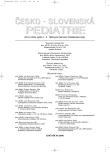The Therapy of the Deep Cartilage Defects in the Knee Joint by the Transplantation of Cultivated Autologous Chondrocytes in Children and Adolescents
Léčba hlubokých chondrálních defektů kolenního kloubu u dětí a adolescentů transplantací kultivovaných autologních chondrocytů
Úvod:
Studie je zaměřena na léčbu hlubokých defektů chrupavky u dětí a adolescentů. Ve všech případech byla použita metoda transplantace kultivovaných autologních chondrocytů.
Materiál a metodika:
Čerstvé úrazy kolena (do 48 hodin) nebo jejich následky, jejichž důsledkem bylo v obou případech nitrokloubní poškození a výskyt fokálního hlubokého defektu chrupavky, představovaly chirurgické indikace pro transplantaci chrupavky. Defekty byly klasifikovány před operací podle Bessettova a Hunterova skóre a během diagnostické artroskopie podle Outerbridgeova skóre. V případě pozitivního nálezu byl odebrán vzorek chrupavky z nezátěžové zóny v sulcus femoralis. Kultivace chondrocytů ve Tkáňové bance trvala 28 až 42 dní, poté byl formován solidní chondrograft, který byl připraven k operaci. Pro fixaci chondrograftu během transplantace bylo použito fibrinové lepidlo Tissucol.
Výsledky:
Od července 2003 do listopadu 2005 léčili autoři 12 pacientů touto metodou: 8 chlapců, 4 dívky. Věkové rozmezí bylo 10 až 18 let, průměrný věk 15,2 roku. Doba sledování činila 7 až 20 měsíců, průměrně 12,2 měsíce. NMR vyšetření byla provedeno před a po operaci v intervalech 2 týdny, 2–6 měsíců a 1 rok. Klinické výsledky byly hodnoceny podle skóre Meyerse, Tegnera a Lysholma-Gillquista.
Závěr:
Ve srovnání mezi dobou před operací a po skončení léčení došlo k signifikantnímu zlepšení klinických funkcí kolena, rovněž tak ve srovnání s kontralaterálním neporaněným kloubem. Hodnocení skenů nukleární magnetické rezonance (NMR) prokázalo dobrou integraci chondrograftu.
Klíčová slova:
kolenní kloub, dítě, adolescent, úraz, chondrocyt, transplantace chrupavky
Authors:
M. Handl 1; T. Trč 1; M. Hanus 1; E. Šťastný 1; M. Fricová-Poulová 2; J. Neuwirth 2; J. Adler 3; D. Havranová 3; F. Varga 4
Authors‘ workplace:
Ortopedická klinika dětí a dospělých 2. LF UK, FN Motol, Praha
přednosta doc. MUDr. T. Trč, CSc.
1; Klinika zobrazovacích metod 2. LF UK, FN Motol, Praha
přednosta prof. MUDr. J. Neuwirth, CSc.
2; Tkáňová banka, FN Brno-Bohunice
přednostka MUDr. D. Havranová
3; Oddělení biofyziky 2. LF UK, FN Motol, Praha
přednosta doc. RNDr. E. Amler, CSc.
4
Published in:
Čes-slov Pediat 2006; 61 (7-8): 413-423.
Category:
Original Papers
Overview
Introduction:
The study was focused on the treatment of the deep cartilage defects in the knee joint in children and adolescents. The method of cultivated autologous chondrocyte transplantation in the form of a solid chondrograft was used in all cases.
Material and methods:
Fresh injuries of the knee joint or sequelae of its intraarticular derangement resulting in a deep focal cartilage defect were surgical indications for the cartilage transplantation. The defects were classified preoperatively according to the Bessette and Hunter score and intraoperatively during arthroscopy according to the Outerbridge score. In the case of a positive finding, a full cartilage sample was harvested from the non-weight-bearing zone of the trochlea femoris. In the Tissue Bank, a solid chondrograft was formed from cultivated chondrocytes over a period of 28 to 42 days and then prepared for the transplantation. Tissucol tissue glue was used for graft fixation.
Results:
From July 2003 to November 2005 the 12 patients (8 males and 4 females) were treated by this method. The age range was 10 to 18 years, with a mean age of 15.2 years. The follow-up periods ranged from 7 to 20 months with an average of 12.2 months. The magnetic resonance imaging (MRI) scans were evaluated before the surgery and after that at intervals of 2 w, 2–6 m and 1 year. The clinical results were evaluated according to the Meyers, Tegner and Lysholm-Gillquist scores.
Conclusions:
The clinical function of the knee joint showed significant improvement in the comparison between initial and final follow-up terms and also results comparing to the contralateral non-injured knee were improved. MRI evaluation showed a good integration of chondrografts.
Key words:
knee point, children and adolescent, injury, chondrocyte, cartilage transplantation
Labels
Neonatology Paediatrics General practitioner for children and adolescentsArticle was published in
Czech-Slovak Pediatrics

2006 Issue 7-8
- What Effect Can Be Expected from Limosilactobacillus reuteri in Mucositis and Peri-Implantitis?
- The Importance of Limosilactobacillus reuteri in Administration to Diabetics with Gingivitis
Most read in this issue
- Alobar Holoprosencephaly – A Case Report of Two Cases
- Indication and Principles of Molecular-Genetic Investigation
- The Therapy of the Deep Cartilage Defects in the Knee Joint by the Transplantation of Cultivated Autologous Chondrocytes in Children and Adolescents
- Cardiopulmonary Resuscitation – Novel Recommended Procedures
